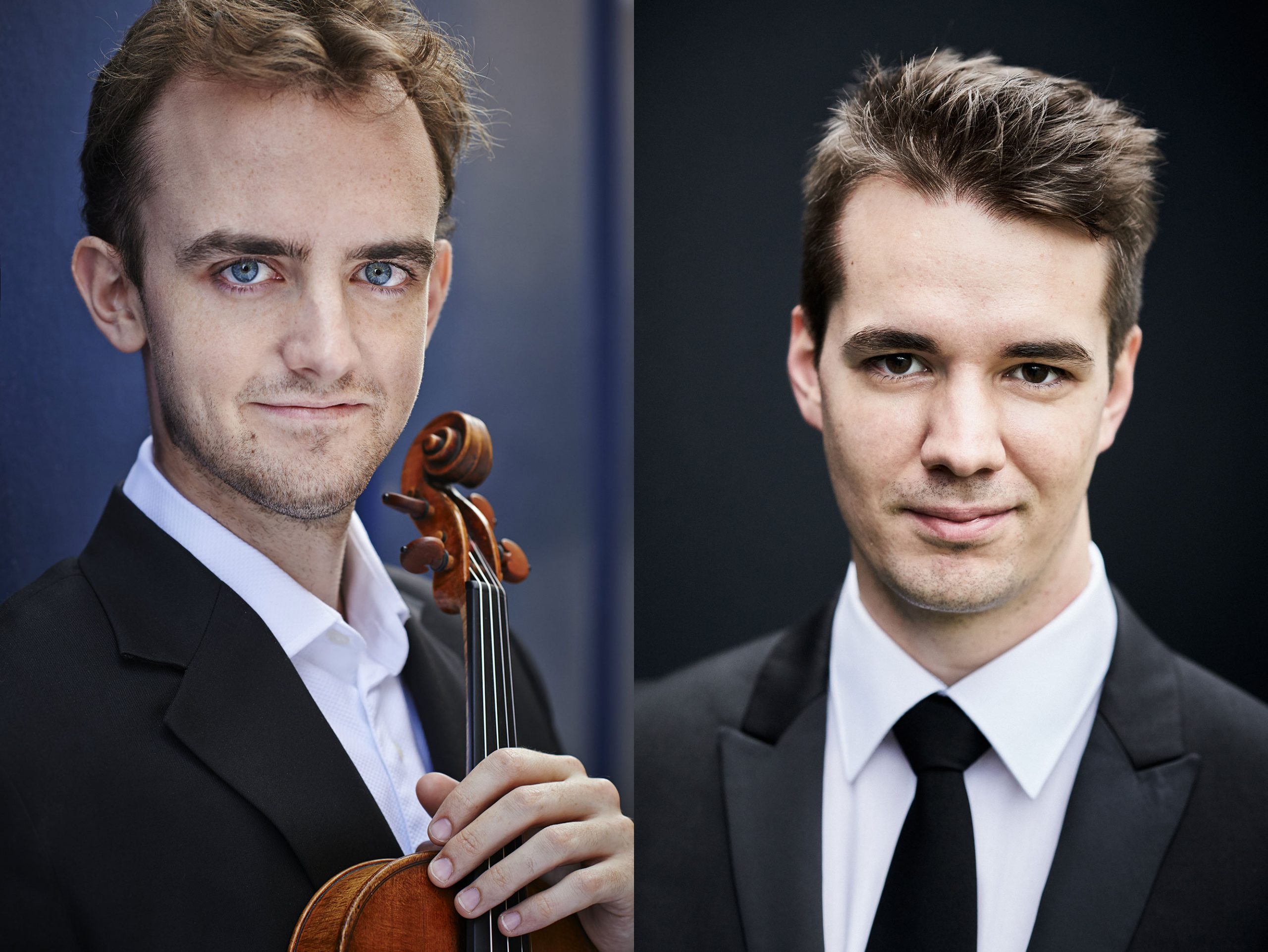
Program Notes: Violinist Benjamin Baker and Pianist Daniel Lebhardt
Rising star violinist Benjamin Baker, a New Zealand native, and acclaimed young Hungarian pianist Daniel Lebhardt come to Guarneri Hall to play a program spanning three centuries on Thursday, November 9, 2019 at 6:30 pm. Full concert details and tickets
Wolfgang Amadeus Mozart (1756-1791): Sonata No. 28 in E flat Major, K. 380
Mozart composed sonatas for pianoforte and violin at intervals throughout most of his career. Early efforts appear in 1766 with the last of these coming in 1788, by which time the composer was well-established in Vienna. Mozart’s development as a composer can be tracked to a large extent through a growing sophistication in these works over time.
Soon after his arrival in Vienna in 1781 Mozart took on a new pupil, Josepha Auernhammer, to whom he dedicated the sonata K. 380. It was published as part of a set of five sonatas by Artaria, who would become Mozart’s principal publisher until his death in 1791. While some biographers have speculated that the dedication was prompted by a romantic connection between Auernhammer and Mozart, it seems more likely to have been an expression of Mozart’s gratitude for his capable student’s assistance in proofing the first impressions from the publisher.
The K. 380 Sonata is constructed in a grand, three-movement form with a brilliant, full-scale Sonata Allegro first movement. In the middle Andante con moto in G minor, we find Mozart in a restless mood. Moments of exotic chromaticism appear, a first glimpse of a device that will turn up with regularity in mature works over the rest of Mozart’s career. The final Rondeau takes the form of a lively hunting song, setting up a rousing close to the work.
Aaron Copland (1900-1990): Sonata for Violin and Piano
Copland dedicated his Sonata for Violin and Piano to the memory of his friend Lieutenant Harry H. Dunham, who died in combat in the South Pacific a short time after the piece was finished in 1943. Copland recalled about his work on the piece, “Certain qualities of the American folk tune had become part of my natural style of composing, and they are echoed in the Sonata. It is composed in the usual three movements, with the last two to be played without pause.”
The first movement employs the interval of a perfect fourth as the basis for lyrical sections contrasting with sudden shifts in mood to quick and fleeting material. The second movement is written in a spartan, contrapuntal A:B:A form. The third movement is at times angular, with dislocating rhythms, and at other times melodic. The short coda reintroduces a theme from the opening movement, bringing the work to an end with a feeling of cyclical closure. Copland’s Sonata for Violin and Piano was premiered at Town Hall, New York in January 1944 by Ruth Posselt and Copland himself.
John Cage (1912–1992): Six Melodies for Violin and Piano
John Cage is remembered as a ground-breaking musical innovator and nonconformist but his muse was definitely substance, not artifice. Cage was driven by deep and poetic musical impulses that resulted in a relentless search for novel distillations of musical expression. The results of his experiments would eventually have a profound effect on music composition from the middle of the 20th century onward.
While Arnold Schoenberg (with whom Cage studied for two years in the 1930s) had pushed the boundaries of music beyond traditional diatonic harmony in the early part of the 20th century, Cage went further still, striving to break free from the constraints of conventional harmony altogether.
In Six Melodies for Violin and Piano (composed in 1950), the composer employs a “gamut” technique and “nested rhythmic proportions.” One or both of the work’s instruments are called on to produce intervals identified on a menu as “gamuts.” The gamuts are notated in varying sequences to produce a melody irrespective of normal harmonic movement. The resulting music is sparse and atmospheric, in Cage’s words designed to “sober and quiet the mind, thus rendering it susceptible to divine influences.”
Dedicated to the German expatriate artists Josef and Anni Albers, with whom Cage had a close relationship, Six Melodies for Violin and Piano is a close cousin to Cage’s String Quartet in Four Parts, with which it shares compositional techniques and character; both were premiered in Cambridge, Massachusetts in November 1959.
Johannes Brahms (1833-1897): Violin Sonata No. 3 in D minor, Op.108
The last of three Sonatas that Brahms wrote for Violin and Piano, the Opus 108 in D minor is the most direct and lean in style, despite having four movements while the others have three.
An urgent, silvery first theme in D minor opens the piece, becoming dramatic at times and sinister at others, and alternating with a warm second theme in the relative major key. The second movement begins as a sarabande in D major, climbing two tall mountains before finally peacefully coming to rest. The third movement is an agitated scherzo. The piece closes with a fiery finale in D minor.
Composed between 1886 and 1888, the Opus 108 sonata is dedicated to Brahms’ friend and colleague Hans von Bülow. It was premiered in Budapest in 1888 with Jenő Hubay on violin and the composer at the piano.

